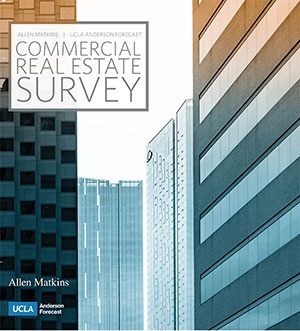The Spring/Summer 2019 Allen Matkins/UCLA Anderson Forecast California Commercial Real Estate Survey reveals a more optimistic outlook than has been observed the last couple of years. The biannual survey projects a three-year-ahead outlook for California’s commercial real estate industry and forecasts potential opportunities and challenges affecting the office, multi-family, retail, and industrial sectors.
The positive prediction for 2022 development leapfrogs UCLA Anderson Forecast’s prediction of a very weak economy through 2020 to its prediction of faster growth thereafter. The results indicate, that although construction activity is expected to slow down over the next 18 months, developers are already gearing up for the next CRE expansionary cycle.
Office space market sentiment returns to confidence
While previous surveys for office markets had indicated that the peak had been reached, the latest survey—taken in April and May 2019—shows that there is a return to confidence for 2022. The Survey tells us that after a predicted downturn in 2020, office space developers see a post-near-recession demand surge that will improve rental and occupancy rates. In San Francisco, Silicon Valley, and the East Bay, there is the expectation that rental rates adjusted for inflation will improve significantly after a short pause over the next couple of years.
In Southern California, survey participants have signaled in previous years that markets measured by occupancy and rental rates are going to improve, though somewhat marginally. The latest Survey continues that trend, with Orange County being the exception, as it is still struggling with an overhang of space and tepid job creation.
Hot market in industrial market because of e-commerce warehouse demand
Industrial markets continue to be where the action is in non-residential commercial real estate development. Since California began transforming from a factory economy to an information economy, this space has shifted to being dominated by warehouses. In spite of the impact of the trade dispute with China, the panels for the East Bay, Los Angeles, and Orange County are looking at very good markets becoming even more lucrative by 2022. The already red-hot markets in San Joaquin County and the Inland Empire will continue to be so as the market in 2022 is predicted to be the same as today for these areas.
Near the ports and the population centers, a densification of warehouses is beginning to occur, where multi-story buildings with productivity enhanced by robotics are becoming more prominent. Even though there is still technology development in process for high-rise warehouses, this appears to be what is driving values and optimism in the coastal areas.
Retail markets show signs of improvement
While retail continues to be the weakest asset in commercial real estate, the latest Survey shows that after two years of pessimism in the Bay Area, the panel now reports that it is optimistic about 2022. In Southern California there remains general pessimism, but it is not as uniform across panel members as in previous surveys. The explanation for this change in both regions has to do with the fact that demand has been shrinking of late due to the strong move to online shopping, and therefore, little new development has been occurring.
With very little building of new space and an economy forecast to grow at normal rates in the early part of the coming decade, there are going to be opportunities for retail to support new housing as well as upgrades associated with gentrification and densification. This Survey shows that retail markets will see some improvement, particularly in the Bay Area, and there will be more opportunities down the line as retail’s brick-and-mortar capital continues to realign to meet 21st century needs.
Multi-family market holds steady (but pessimism in Bay Area)
The multi-family market has been tight since early in this economic expansion. There were no big swings in multi-family developer expectations for the next three years for Los Angeles, Orange County, and San Diego. However, in the Bay Area, developers see 2022 as having worse economics than 2019. Bay Area developers have pulled back on new development in the last six months, with half of the panelists stating that they will not start a new project in the next 12 months.
In spite of the robust demand for housing in the Bay Area today, explanations for the pessimism among multi-family developers in the Bay Area may include falling home prices, an increase in inventory of homes listed for sale, and the uncertainty with regard to rent control. Though it is too early to tell if there is a trend developing, if uncertainty is causing the building of multi-family projects to wane in the Bay Area, it will only exacerbate the housing shortage there.














